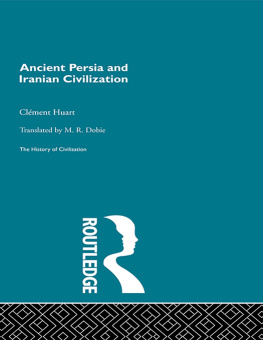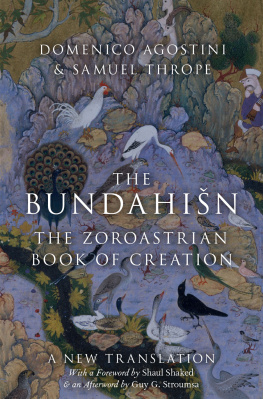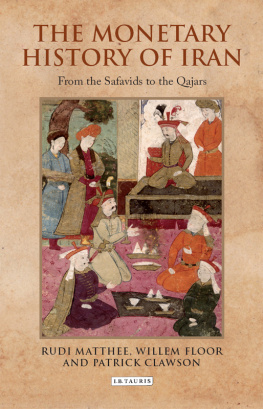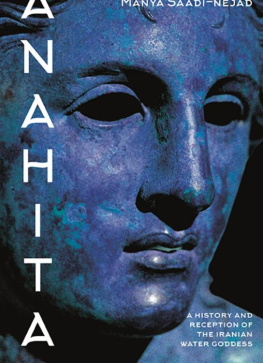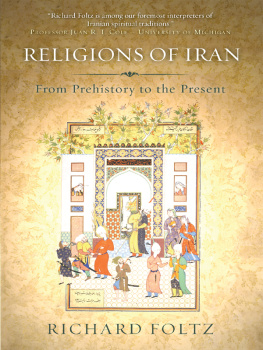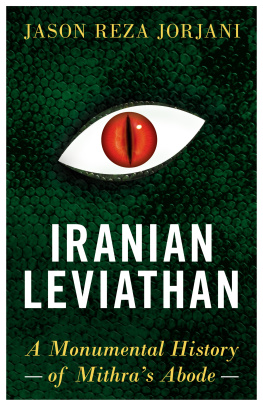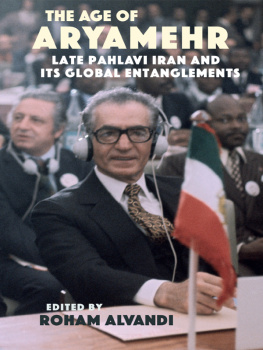Contents
- Introduction
Touraj Daryaee - 1. The Iranian Plateau from Paleolithic Times to the Rise of the Achaemenid Empire
Kamyar Abdi - 2. The Elamites
Daniel T. Potts - 3. Avestan Society
Prods Oktor Skjrv - 4. The Achaemenid Persian Empire (550330 BCE)
A. Shapour Shahbazi - 5. Iran at the Time of Alexander the Great and the Seleucids
Evangelos Venetis - 6. The Arsacid Empire
Edward Dbrowa - 7. The Sasanian Empire (224651 CE)
Touraj Daryaee - 8. Iran in the Early Islamic Period
Michael G. Morony - 9. Medieval Iran
Neguin Yavari - 10. The Mongols in Iran
George E. Lane - 11. Timurids and Turcomans: Transition and Flowering in the Fifteenth Century
Ali Anooshahr - 12. The Safavids in Iranian History (15011722)
Kathryn Babayan - 13. The Afghan Interlude and the Zand and Afshar Dynasties (172295)
Kamran Scot Aghaie - 14. Qajar Iran (17951921)
Mansoureh Ettehadieh Nezam-Mafi - 15. The Pahlavi Era: Iranian Modernity in Global Context
Afshin Matin-Asgari - 16. Iran after Revolution (19792009)
Maziar Behrooz
Guide
Page List
THE OXFORD HANDBOOK OF
IRANIAN HISTORY
THE OXFORD HANDBOOK OF
IRANIAN HISTORY
Edited by
TOURAJ DARYAEE


Oxford University Press, Inc., publishes works that further Oxford Universitys objective of excellence in research, scholarship, and education.
Oxford New York
Auckland Cape Town Dar es Salaam Hong Kong Karachi
Kuala Lumpur Madrid Melbourne Mexico City Nairobi
New Delhi Shanghai Taipei Toronto
With offices in
Argentina Austria Brazil Chile Czech Republic France Greece
Guatemala Hungary Italy Japan Poland Portugal Singapore
South Korea Switzerland Thailand Turkey Ukraine Vietnam
Copyright 2012 by Oxford University Press, Inc.
Published by Oxford University Press, Inc.
198 Madison Avenue, New York, New York 10016
www.oup.com
Oxford is a registered trademark of Oxford University Press
All rights reserved. No part of this publication may be reproduced, stored in a retrieval system, or transmitted, in any form or by any means, electronic, mechanical, photocopying, recording, or otherwise, without the prior permission of Oxford University Press.
Library of Congress Cataloging-in-Publication Data
The Oxford handbook of Iranian history / edited by Touraj Daryaee.
p. cm. (Oxford handbooks)
Includes bibliographical references and index.
ISBN 9780199732159 (hardcover : alk. paper)
1. IranHistory. I. Daryaee, Touraj II. Title: Handbook of Iranian history.
DS272.O94 2011
955dc22 2010043640
1 3 5 7 9 8 6 4 2
Printed in the United States of America
on acid-free paper
For Iraj Afshar and those like him
who have dedicated their lives
to the study of what has
come to pass in the Iranian world
ACKNOWLEDGMENTS
THE reason for this books existence is that most edited or single-author books tend to emphasize one period over another in Iranian history, or not to provide equal coverage for the entire history of Iran. Hence, there is a need for a book that attempts to elucidate the history of the Iranian Plateau and those who have lived and died there and who have created a culture that has influenced the region and the continent in many ways. This book attempts to do justice to the entire history of Iran, not just its modern period. This is the first and foremost difference from other books written on the history of Iran. Secondly, the experts in each area have written on their respective periods in a manner that provides comprehensible information for students at the university level and for the educated layperson.
The authors of this book are historians, philologists, and experts on the Iranian world. Here they have tried to provide outlines of Iranian history and culture in a meaningful and clear manner for the English-speaking audience. It has taken some four years for this book to reach its final form, and not all of the authors have lived to see it in print. A. Shapour Shahbazi was a beloved historian of ancient Iran whose untimely death left us with deep sadness. I wish to thank all the authors for their work.
There are a number of people I wish to thank for making the completion of this book possible. Afshin Marashi initially discussed the reasons for and parameters of the project for a history of Iran with me. Ali Mousavi was helpful in discussing the questions I had posed about the material culture of Iran. Khodadad Rezakhani, Sara Mashayekh, and Conrad Harter prepared the genealogical table, Warren Soward and Yuhan S.-D. Vevaina helped with the editing of the entire manuscript. I would like to also thank Iraj Afshar for taking me on journeys throughout Iran in the past decade so that I was able to photograph the country. I would like to thank Linda Komaroff, who generously allowed for the publication of a Persian miniature from the manuscript collection of the Los Angeles County Museum of Art. I would also like to thank Sonia Tycko, who patiently saw the manuscript through in a timely manner. Finally, I would like to thank Nancy Toff, executive editor at Oxford University Press, for her help and guidance and for making the publication of this book possible.
Touraj Daryaee
CONTENTS
Touraj Daryaee
Kamyar Abdi
Daniel T. Potts
Prods Oktor Skjrv
A. Shapour Shahbazi
Evangelos Venetis
Edward Dbrowa
Touraj Daryaee
Michael G. Morony
Neguin Yavari
George E. Lane
Ali Anooshahr
Kathryn Babayan
Kamran Scot Aghaie
Mansoureh Ettehadieh Nezam-Mafi
Afshin Matin-Asgari
Maziar Behrooz
Kamyar Abdi was born in Tabriz, Iran, in 1969. He received his BA in archaeology from Tehran University and his PhD in anthropology from the University of Michigan in 2002. From 2002 to 2008 he was an assistant professor of anthropology at Dartmouth College, and since 2008 he has been an associate professor of archaeology at Science and Research University in Tehran. Abdi has done fieldwork in several archaeological sites in Iran, Turkey, and the United States. His main research interest is the sociopolitical organization of Elam, especially during the Proto-Elamite to Old Elamite period, and the transition from the Neo-Elamite to Achaemenid period.
Kamran Aghaie received his PhD in history from the University of California, Los Angeles. He is associate professor and director of the Center for Middle Eastern Studies at the University of Texas at Austin. His work mainly deals with Islamic studies, Shiism, and modern Iranian and Middle Eastern history, as well as world history, historiography, religious studies, nationalism, gender studies, and economic history. He teaches Iranian and Middle Eastern history and is an expert on Shiism.
Ali Anooshahr teaches world history as well as comparative premodern Islamic history at the University of California, Davis. He received his BA in humanities from the University of Texas at Austin (1994), and received his MA and PhD in Islamic history from the University of California, Los Angeles (2005). He has taught at UCLA, Santa Monica College, Cal State LA, Cal State San Marcos, and Saint Xavier University. He also studies memory, self-fashioning, and intertextuality in the writings of three ghazi (holy warrior) kings of the premodern period, Sultan Mahmud of Ghazna; Babur, the founder of the Mughal dynasty; and the Ottoman Sultan Murad II.


